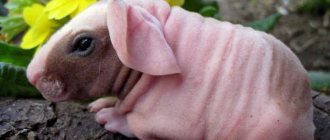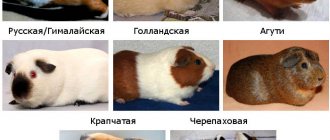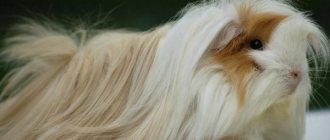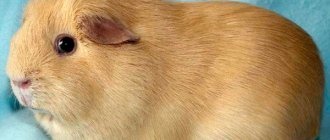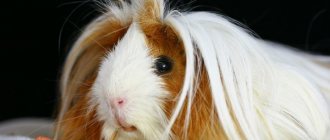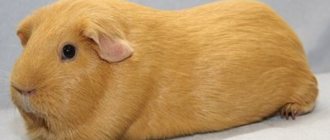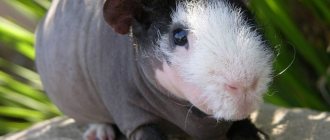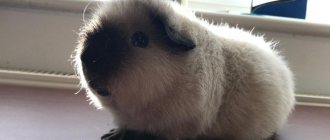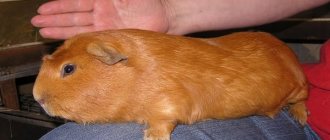Amazing rosette guinea pig, how it differs from other breeds. Appearance, coat and color. Behavior and character of animals. Advantages and disadvantages of the breed. How to properly maintain and care for it at home. Feeding, healthy and unhealthy foods.
Guinea pigs have a huge number of fans around the world. These are wonderful, affectionate, unique pets. There are several breeds of these beautiful animals, they differ in fur, color, character and other parameters.
One of the most popular is the rosette guinea pig, which has very unusual fur. Next, we will take a closer look at the breed, learn about its characteristics, and also learn how to properly care for the animal, how to organize its diet, and much more.
History of the breed
In fact, there is not much information regarding the origin of this breed. There are quite a lot of assumptions about how exactly the breed appeared, but there are simply no supporting facts. It is known for sure that the ancestors of these amazing animals come from South America.
Unfortunately, previously these animals were not treated the way they are now. Historians say that in the past they were used by people as a source of food and also as sacrificial animals.
It was only in 1850 that animals of this breed came to England, after which they spread throughout Europe and the whole world.
Description
This breed has a distinctive feature, namely, there are depressions on the fur that form a rosette, which is where the name of the breed comes from.
A genetic mutation has led to a change in the direction of hair growth, which is why it curls into a spiral. The appearance of such spirals is very similar to a whirlpool.
This breed has generally accepted standards, according to which there must be a certain number of rosettes, namely no less than 8, but no more than 12. In addition, the purity of the breed is indicated by the symmetrical arrangement of rosettes.
Vortex location:
- In the area above the nose - at least 2.
- In the shoulder area - 1.
- On the body – 4 (maybe more).
- On the hips - 1.
The wool spirals are surrounded by a comb, which should have a clear outline. It is also worth saying that in females the rosettes are less pronounced than in males, this is due to the fact that girls have whiter, softer fur. The formation of rosettes occurs before the age of 5 months, only after which can their quantity and quality be assessed.
Coloring
The most common are speckled pigs; their coat consists of an alternation of black and red hair, while solid spots are not allowed. If light hairs dominate, then the rodents are classified as light variegated, and if there are significantly more black hairs, they are classified as dark variegated.
There are also tortoiseshell pets whose rosettes are of different colors and each of them should not have other color impurities. The order of the sockets does not matter.
The third color is roan, when the main color is diluted with white hairs, the so-called grey. The following types of roanity are distinguished:
- blue - a mix of black and white,
- strawberry - a mixture of white and red (red),
- variegated when the body contains black, red and white shades.
The fourth option is selfie or plain. The most popular and frequently encountered are black and red selfies.
Description of the appearance of the animal
These rodents have an average body size; adult animals reach a body length of 26-30 centimeters. The weight of an adult female is about 700-900 g, males are larger, their weight is 800-1000 g. The body is quite muscular and has a rectangular shape.
The head is triangular in shape, slightly elongated with a blunt muzzle. The little animal has wonderful whiskers on its cheeks. Small nose.
The ears are medium in size and set wide apart. The edges of the ears have a wavy frame. Convex and residually large eyes.
The neck is very short, so the transition from head to body is poorly visible. A wool comb runs along the back of the spine. The paws are short, the toes have claws.
Disadvantages of the breed
Purebred breeds must meet strict requirements; if their appearance does not meet them, it is considered a fault.
These disadvantages include:
- Double sockets.
- Large body sizes.
- Fur that is too long or short.
- Curvature of the limbs.
- Color mismatch.
Any of the deviations affect the ratings given to animals at exhibitions. There are also more serious shortcomings for which you will be disqualified:
- If there are bald spots on the fur.
- Sagging back.
- If there are folds and tears on the ears.
- Slanted butt.
Character and behavior
These are very inquisitive and active animals, they are interested in absolutely everything that happens around them, and want to meet and learn new things.
They quickly get used to people and their owner, they love to spend time with him and sit in his arms for a long time. Be prepared for the fact that your beloved pet will be waiting for you impatiently, and when he does, he will greet you with a squeak. He also knows how to beg for treats, also using his cute squeaks.
They also behave very affectionately with children; aggression is absolutely not typical for them. These pets are afraid of loud sounds and begin to get nervous if they start raising their voices in the apartment or if the TV is playing loudly.
Remember that they do not get along with their relatives. Two males who will live in the same territory will definitely conflict and fight. Such clashes often cause serious injury to animals.
Health, how long do they live?
The lifespan of these amazing animals is on average 6-8 years; under favorable conditions, proper care and nutrition, they can live up to 10 years.
Of course, a lot depends on the animal’s immune system and the presence of any diseases, but representatives of this breed rarely get sick, provided they are properly cared for.
Danger for rodents are ticks, fleas, and helminths, which, in addition to weakening the immune system, can lead to the development of various diseases.
Due to poor nutrition, diseases of the gastrointestinal tract can develop. Animals can also develop eye diseases, such as conjunctivitis.
The influence of interbreed differences
Factors that influence the lifespan of guinea pigs include breed (although of all the reasons it plays the least role).
Existing varieties can be divided into 3 large groups.
Longhair
Abyssinian guinea pig
Such pets require careful care of their fur and live on average about 5-6 years. These include:
- Peruvian. It is distinguished by the maximum length of the hairs and the obligatory bangs covering the eyes.
- Rosette (Abyssinian). The bizarre growth of the coat is characterized by a multidirectional arrangement, forming curls with clear boundaries (“rosettes”). For animals performing at exhibitions, the number of these curls is important (the owner of the least number loses).
- Sheltie. It is similar to the Peruvian, but has a peculiar comb on the head (the fur is located in the opposite direction).
- Coronet. Long-haired result of crossing Sheltie and Crested, distinguished by a “crown” of wool.
Shorthair
American guinea pig
Those with short hair are distinguished by a wide color palette, do not require complex care and can live up to 8 years. These include:
- Crested. The woolly white “rosette” on the head takes the shape of a “crown”.
- American. One of the most popular types of animals with short hair. The classic version with a smooth, shiny coat that does not have “rosettes” or “crowns”.
- Texel. The hair has a curly structure and is prone to frequent tangling, so it requires more careful care than other representatives of this group.
- Himalayan. A rare breed with a unique Siamese cat color. Despite the lack of official recognition, the coloring gained popularity, which affected the final cost.
- Royal (“rex”) It has no guard hairs, but has dense and elastic fur.
- American Teddy. The thick coat has chocolate or light sand colors and consists of hard hairs.
Hairless
Skinny guinea pigs
Hypoallergenic breeds of hairless rodents, bred by the work of dermatologists, live for about 5 years (in rare cases, the mark reaches 8). These include:
- Skinny. Wool is present only on the paws and face.
- Baldwin. They have elastic skin, devoid of hair follicles. A newborn animal is distinguished by the presence of a fur coat, which disappears within a couple of months after its birth.
Among the presented breeds of guinea pigs, short-haired ones live longer, which is explained by ease of care and the absence of specific gene diseases.
IMPORTANT! It is worth giving the position to the breeders. Thanks to painstaking work, they were able to increase the average life expectancy of hairless breeds. Initially, such pets were distinguished by weak immunity, reducing the maximum age to the level of other small rodents (hamsters, rats).
Care and maintenance at home
Proper care of these little animals is quite simple and does not require complex and time-consuming manipulations. To keep a rodent you need to purchase a spacious cage.
The cage must have a standard set: a drinking bowl, a feeding trough, a hay barn and a house. Be sure to purchase a special comb to care for the fur. Also, we must not forget about the filler.
Cell
This is a fairly large rodent, so the cage should not only be comfortable, but also spacious. If you follow the recommendations of experienced breeders, then there should be 0.7 m² of free space per animal and these are the minimum dimensions.
For one animal, a cage measuring 100 x 70 cm is purchased; of course, you can have a larger one, which will be an advantage. The height of the cage must be at least 40 centimeters. There are also some requirements for a rodent’s home; it must have good ventilation and be easy to clean.
It is very important what material the home is made of; wood and metal are allowed. It is desirable that it has a pull-out plastic tray that is easy to pull out and convenient to wash.
Some people choose aquariums to keep pigs, but it should be said right away that this is a bad option. The fact is that it has 4 blank walls and very poor ventilation. The release of vapors from urine and feces will not be able to erode, they will accumulate in the middle, and the animal will breathe vapors of ammonia and hydrogen sulfide, and this is very harmful to health.
Interior arrangement
You need to take care of the filler, which is placed on the bottom of the cage. The filler can be ordinary torn paper or pressed sawdust. If you choose shavings, you should be sure that they do not contain coniferous tree shavings.
The fact is that such tree species contain essential oils that can cause an allergic reaction and lead to swelling of the respiratory tract.
Also in the cage there should be a house where the animal can hide in case of fright, if it wants to take a break from people, or just sleep.
Such a house must have dimensions of at least 50 x 20 and a height of at least 12 centimeters. Mandatory accessories are a feeder, you will need 2 of them, one for food, the other for vegetables, a drinking bowl and a hay barn.
It is better to use a nipple drinker, the water stays fresh longer in it, and the animal will not be able to turn it over. Such drinking bowls are installed outside the cage, and in the cage there is only a spout from which water comes.
You can install tunnels in a cage, but only if the cage is spacious and has enough free space. Regarding the running wheel, it is prohibited for installation on guinea pigs.
This is due to the fact that they have a very weak spine and the slightest injury from a fall can cause very serious consequences.
Also, two-level cells are not desirable, for the same reason. If you do make such a cage, be sure to install flat ladders with transverse slats to eliminate the risk of falling.
Where to put the cage
You should choose a place where there are no large temperature changes, since pigs do not tolerate such fluctuations very well. The ideal temperature for them is 20-25°. They shouldn't be hot or cold.
Remember that you cannot place the cage near a battery, and it should not be in a draft. Do not expose your pet to the sun; direct sunlight will lead to overheating.
Hygiene
These cute animals try to take care of themselves as much as possible on their own, but for a number of reasons they need human help. Caring for a guinea pig consists of standard procedures and there is nothing special about them, the only thing that needs to be paid more attention to is the long fur.
Wool
In order to ensure proper care of the animal’s fur, you will need a special comb and a brush with natural bristles. The combing procedure is carried out once every 3 days. It is also recommended to wipe the fur with a damp cloth once a week.
Bathing
It should be said right away that bathing is not a mandatory procedure; it is carried out only in extreme cases, when the fur is very dirty and it is not possible to remove the dirt with a napkin.
For bathing you will need a container, it is better to use a basin; the sides should not be higher than 40-43 centimeters. You should not think that a guinea pig will be delighted with bathing and will quietly enjoy the water procedures; this happens very rarely. They often resist and resist in every possible way, so you will need to be patient.
The fur of the animal is very tough, it will not be easy to wet it and then rinse it thoroughly. Since they have very delicate skin, you need to purchase a special shampoo; it can be replaced with shampoo for infants.
After water treatments, the rodent should be wrapped in a towel and kept warm so as not to catch a cold. Eliminate any drafts; after complete drying, you can release it.
Ears
Ear care falls entirely on the individual, since they cannot clean them on their own. Once a week, be sure to inspect the inside of the sink.
If there is sulfur, it must be removed. To do this, use a cotton pad, which is moistened in a special lotion, it can be purchased at a veterinary pharmacy.
If during examination you see brown discharge, be sure to consult a doctor. Also watch your animal, if it scratches its ears and head, this most likely indicates an infection with ear mites, which causes brown wax to appear.
Claws
Under natural conditions, rosette rodents wear down their claws when they dig burrows and get their food. At home, there are no such conditions, so the claws do not grind down and they must be trimmed; if this is not done, pododermatitis will begin, and the fingers will gradually become bent. To trim claws, you need to purchase a nail clipper, suitable for cats.
This procedure is carried out approximately once a month; you should monitor the condition of the nails; if the length of the transparent part has reached 2 mm, then you can trim it.
To carry it out, you need to choose a well-lit place, keep your pet as close to the surface as possible, it is better to put a pillow, so that if he falls, he will not harm himself. If he struggles violently and even bites, you can wrap him in a towel.
There is a blood vessel in the middle of the claw; when cutting, you should be as careful as possible so as not to touch it, otherwise bleeding will begin and the animal will be in great pain.
White claws are clearly visible and will be visible; black claws are not so visible, so you can take a flashlight and bring it close to the nail. Cut to 1mm length.
For the first time, nail cutting is carried out no earlier than three months of age, then this procedure should be carried out regularly to prevent deformation.
Other factors
Feeding is not the only factor influencing the health of cavy.
- A cramped space has a negative impact on your pet's condition. She needs a spacious home (cage, container, aquarium), at least 20x50 cm in size. The larger the house, the more fun and healthy the pig will be. Insufficient activity does not allow the animal’s muscles to develop and gain good physical shape.
- Excellent health depends to a large extent on maintaining cleanliness in the pig’s home. A special filler is used as bedding, but sawdust, which absorbs waste well, is also suitable. Once a week, general cleaning is carried out with the treatment of toys and accessories. Drinkers and feeders should be washed daily, this will prevent the proliferation of bacteria that cause various diseases.
- Do not delay visiting a specialist if you feel unwell, or for weighing. Sometimes only weight loss will help identify the presence of a disease or disorder in the absence of common symptoms such as lethargy, apathy, blood in the urine, diarrhea, shortness of breath, sneezing.
Cleaning the cage
A very important component of a pet’s health is the conditions in which it lives. It is absolutely not enough to simply buy a cage and equip it with the necessary accessories; you need to ensure proper care and cleanliness.
The bedding should be changed regularly; the rodent goes to the toilet and feces and urine collect on it. This needs to be done every 5-7 days.
When changing the filler, you need to remove the rodent and remove all equipment. The filler is thrown away and the tray is thoroughly washed with hot water.
Do not use detergents; if the tray is very dirty, you can use soda, but also wash it thoroughly. The feeder also needs to be cleaned and washed, then disinfected with boiling water. They also clean the drinking bowl and, of course, the house.
Features of feeding
The diet of rodents consists only of plant foods. 50% of the total diet is hay, a mixture of grains and fresh vegetables are also given.
You can’t keep them on a mono-diet; you need to give them different vegetables, carrots, zucchini, cucumbers, cauliflower, broccoli. Fruits can also be given, for example, apples, pears, but they are given in small quantities.
They get all vitamins and microelements from food, so be sure to give them greens in warm weather. They love plantain, dandelion leaves, and clover.
Be sure to give them branches of fruit trees and shrubs. Thanks to the twigs, the teeth are properly ground, and some people also put a mineral stone in the cage.
Be sure to check out the list of foods that are prohibited for feeding guinea pigs:
- Meat and fish in any form.
- Eggs.
- Smoked products.
- Sausages.
- Canned vegetables, fruits.
- Confectionery.
- Not fresh and rotten vegetables, fruits, root vegetables.
Advantages and disadvantages of content
Thanks to its appearance, the rosette guinea pig has found a huge number of fans around the world. But besides the fact that they look very beautiful, they have other advantages, which we will look at later.
But you shouldn’t think that everything is so simple, since there are also some disadvantages.
| Advantages | Flaws |
| They are friendly, quickly make contact and get used to the owner | They don't get along with their relatives |
| Does not require a special diet | They require attention and may squeak loudly if they are hungry or not getting enough attention. |
| Easy care | Difficulties in breeding |
| Good health | |
| Long life expectancy | |
| Doesn't require much storage space |
Who is more profitable to buy a pet from?
The cheapest animals are offered by private owners. You can even buy rodents from them at a purely symbolic price or receive them as a gift. This is due to the fact that some people overestimated their capabilities before purchasing. Caring for a pet has become a burden. Such a sale is an attempt to get rid of problems.
Private individuals offer to purchase a pet from 650 to 1,500 rubles. Animals of rare breeds can be bought for 2500-3000.
But such an acquisition is not always profitable. It is unknown in what conditions the animal was kept by careless owners. Often, a pet bought secondhand later develops diseases, even cancer.
The pet store will offer a price higher than that of a private seller on the market. But there are also disadvantages here:
- there is no guarantee that the animal is purebred;
- even if the breed is clearly visible, the rodent has no pedigree or documents;
- sellers cannot vouch for the health of the animals they sell;
- during overexposure in a store, keeping animals does not always meet the standards;
- The real age of the rodent is not indicated to the buyer, only approximate.
In a nursery, rare breeds of rodents will be sold at a high price. But here the owner will tell you exactly how many weeks and days the animal is, who its mother and father were, what the animal’s character is, and will give recommendations on care.
Animals of rare species and colors are offered here at prices ranging from 3,000 to 10,000 rubles.
Golden guinea pig
Guinea pig training
These little animals are easy to train; if you approach this process correctly, they will learn with great pleasure and obey their owner, the main thing is not to forget to encourage the baby’s efforts and treat him with his favorite treats. Next, we will take a closer look at the most popular commands.
Approach by nickname
This is perhaps the simplest command that can be taught to almost any pig.
So, training occurs as follows:
- Place the animal on a flat surface, for example, on a floor, and move away a meter.
- Next, show him the treat and call him by name in a quiet, calm voice.
- As soon as he approaches, give him a treat.
You need to do the training every day, increasing the distance a little each time. Also try to call him by name more often, during feeding, when you pick him up.
Stand
Remember that all training should be carried out only if the animal is in a good mood and is ready for contact, otherwise you should wait and wait for a good moment.
For this trick, follow these guidelines:
- We take our favorite treat and raise it above the “student’s” head.
- Next, we pronounce the command “stand”, which can be replaced with “serve”. The voice should be confident, but at the same time calm and not loud, so as not to frighten.
- The rodent reaches for a treat and stands on its hind legs.
- We give a treat and praise.
It is enough to repeat the training a couple of times, and the socket will please you with the execution of the command.
All around
The principle of training is the same as in the previous case, only here we do not hold the treat above our heads, but make a circle with it. The animal must repeat the hand movement, for which it will be rewarded.
We pronounce the command “circle” or “turn”. Don’t rush to teach him a full circle of 360° at once, start small, 45°, then increase to 90, but last but not least is the most difficult.
Kiss
This is a very simple command and you can easily teach your pet to “kiss”. Everything is quite simple, we take the animal’s favorite treat and place it on our lips.
The rodent, of course, smells it and starts reaching for it to take it, we repeat the command, but it takes its own. So, after a few repetitions, the animal will automatically reach out to you to kiss you.
Lapu
Here you will need to try and be patient, since the trick is much more difficult than the others.
Training takes place according to the following scheme:
- We sit the animal on a chair, and we ourselves sit next to it on the square. You should not leave your guinea pig alone even for a second to prevent it from falling.
- We hold the treat in our right hand, and hold it out with our left hand, palm up.
- With your right hand, slightly lift the pig so that it places its paw on your palm.
- As soon as this happens, we pronounce the command, praise and reward.
Of course, they need to be carried out regularly to get the desired result.
Ball game
This is a fun and very fun training for which you will need a tennis ball and definitely a treat, but it should be long, for example, a strip of carrot.
We follow the scheme:
- We put a treat on the floor and put a ball on top. To get to the food you will need to move the ball.
- As soon as the rodent approaches the ball, you should say the command “push” or “ball”.
- When he completes everything, praise and treats are a must.
You need to repeat it regularly until you yourself understand that everything worked out, and this will happen very soon.
Jumping ring
For this exercise you need a hoop, but its diameter should be about 25 cm. If you don’t find one, you can make it yourself, ordinary wire will do for this, but the edges should be smooth so that the rodent does not get hurt.
So, we place the hoop on the floor in front of the animal, and hold a treat on the other side. We say the command and lure it with a treat, as soon as it has entered the ring; of course, we praise and reward it. Then you can raise the hoop a little, but the height should not exceed 3 cm, as this can harm the guinea pig.
Remember that the owner’s voice should sound quiet and calm, so as not to frighten, but rather to win over.
Owner reviews
The charm and unusualness of Abyssinians encourages owners to choose them as pets. Most reviews from owners are favorable and filled with positive emotions.
Ekaterina, 35 years old
. “In my understanding, Abyssinians are the best option for keeping a home. It took 2 days for my beauty to get used not only to me, but also to family members. Extremely tame, ready to sit for hours to be petted. Cucumber soul - there is a cucumber next to it and it is impossible not to share. We also have a hamster of the Syrian breed - they get along well, sleep almost in an embrace.”
Sofia, 28 years old
. “I have a very sensitive sense of smell, so when choosing a pet I was guided by the absence of “odors.” Abyssinians do not smell at all, and their rosettes are a sea of charm. Our girl is sweet, quiet and calm. He eats well, especially apples. It is enough for her to change the litter once every 2 weeks. I have a preschooler son who is just learning how to take care of pets. “So they established an excellent relationship; there were never any bites, although the child was careless a couple of times.”
Breeding
Regarding the breeding of this breed, not everything is so simple. The fact is that the gene that is responsible for the formation of rosettes, as well as the hardness of the coat, is dominant, which means that in two parents of this breed, the offspring may not have rosettes.
In addition, the genetic modifier marked M plays an important role. In the case when it dominates, the formation of regular rosettes is suppressed. In this case, only combs are formed in the offspring, there are also curls and there are only 2 rosettes and 1 comb.
Don’t think that if you study genetics and all aspects of breeding, everything will work out for you. There are a huge number of factors that influence offspring. Even purebred animals from experienced breeders produce imperfect offspring. Remember that they cannot be crossed with other breeds.
Mating occurs at the age of 4-10 months; there is no need to rush, since the female must get stronger and have good immunity in order to bear and feed the cubs.
The female must weigh at least 700 g. Every 16-20 days, the girl comes into heat; the best time for fertilization is the first six hours, from the beginning of sexual heat.
Pregnancy lasts 63-66 days. Often 3-4 cubs are born, very rarely there are 6 cubs. The more children a female bears, the shorter the gestation period. As a rule, the first labor lasts about 2-3 hours, but subsequent ones are much shorter.
The cubs are born already with fur, in addition to this, the babies immediately see and hear. But that’s not all, babies already have teeth, and already on the second day of life they can try vegetables. It is necessary to place the female and her children and create proper conditions.
How to determine your current age?
Unfortunately, there are no accurate ways to determine the current age of an individual animal down to the month and day; you will have to trust the seller or breeder when you buy an animal. Using the factors below, you can determine the approximate age of your furry friend.
- Young and still gaining strength individuals are always more active and mobile, they cannot sit still for a minute, they poke their noses into literally every corner.
- The height of adult individuals reaches approximately 25-30 cm, which regarding weight, it ranges from 800 to 1000 grams for females and from 1 to 2 kilograms for males. The weight of young (less than a month) individuals rarely reaches more than 500 grams.
- You can tell a lot by the condition of the coat. If it is shiny, young, not crumpled, well-groomed, soft, then according to all these signs you are looking at a young individual no older than 3-4 years. If there is a bald spot, bedsores or hairballs, the individual is over 4 years old.
- The approximate age can also be determined by the incisors: in young individuals they are snow-white, in adults and old individuals the color is close to yellow.
- Claws can also tell a lot about age; it can be determined by the shape and presence of trimmed claws. In addition, the claws of young individuals are slightly transparent and smooth; in older individuals they may be curved in different directions and slightly lumpy.
It is not recommended to buy individuals older than 2 years. As a rule, they are already adapted to strictly defined food and specific conditions of detention. Pets will have a long and painful time getting used to their new diet and environment. Small guinea pigs are much easier to teach something. Moreover, diseases at an early age are much easier to treat than in the period of full maturity.
When purchasing, you should ask the seller for documents indicating the exact current age, as well as birth weight. Based on these two factors, you can determine whether they are trying to deceive you.
For more information about the guinea pig, watch the following video.
